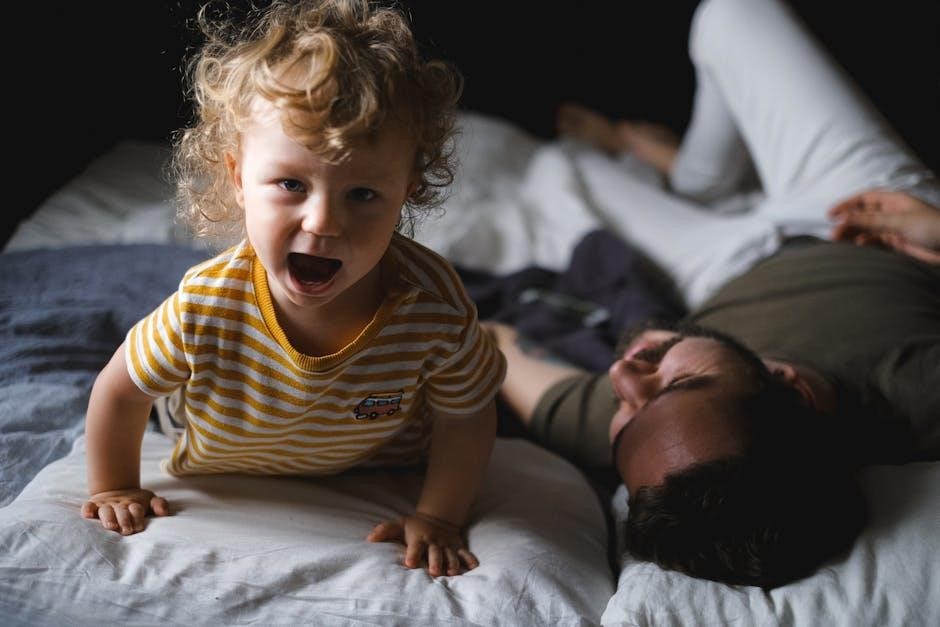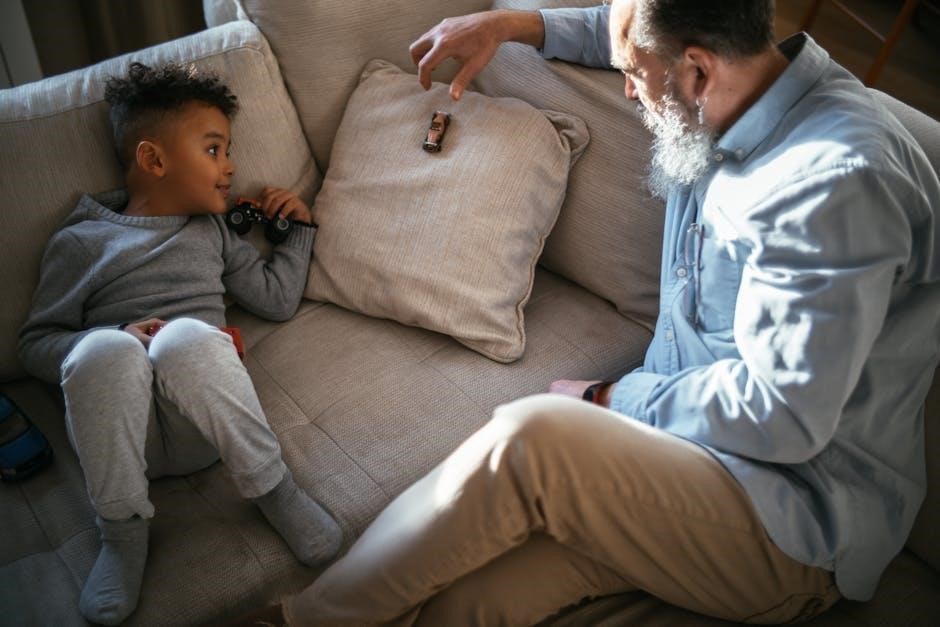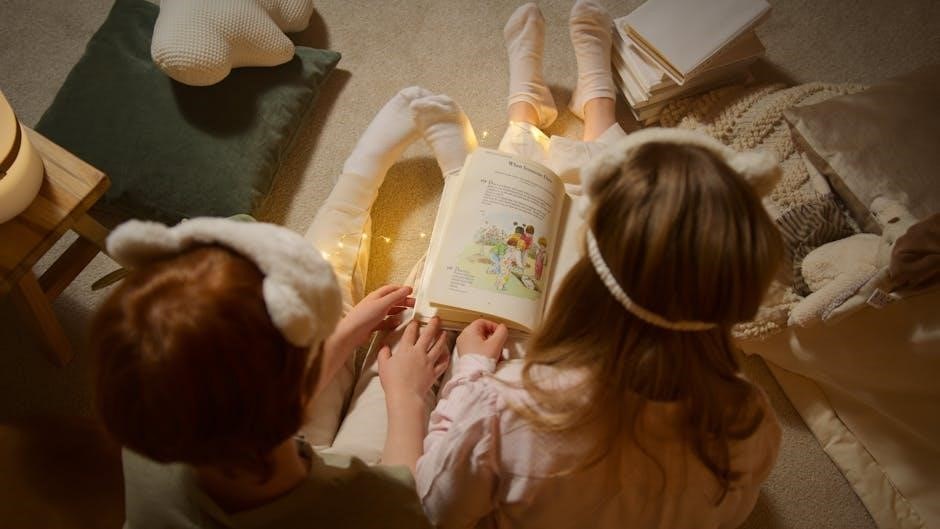The Boy in the Striped Pajamas, a heart-wrenching novel by John Boyne, explores the innocence of childhood amidst the horrors of World War II, offering a poignant perspective on friendship and humanity․
Plot Summary
The Boy in the Striped Pajamas recounts Bruno’s move to Auschwitz, his friendship with Shmuel, and the tragic events that unfold, exploring innocence, prejudice, and war’s brutality․
2․1․ Setting: Auschwitz Concentration Camp
The story unfolds at Auschwitz, a Nazi concentration camp during World War II, where Bruno’s father serves as commandant․ The camp’s grim atmosphere contrasts sharply with Bruno’s innocence, creating tension․ Auschwitz’s oppressive setting, marked by barbed wire, barracks, and chimneys, symbolizes the horrors of the Holocaust․ Bruno’s curiosity draws him to the camp’s perimeter, where he meets Shmuel, a Jewish inmate․ The camp’s stark reality challenges Bruno’s naive view of the world, while its isolation amplifies the boys’ forbidden friendship․ This setting serves as a backdrop for exploring themes of innocence, prejudice, and the tragic consequences of war․ The camp’s eerie environment underscores the moral complexities of the era, shaping Bruno’s journey and ultimate understanding of the world․
2․2․ Bruno’s Journey from Berlin to Auschwitz
Bruno, a young German boy, is uprooted from his idyllic life in Berlin when his father, a Nazi officer, is promoted to commandant of Auschwitz․ The move to the countryside near the concentration camp is unsettling for Bruno, who struggles to adapt to his new surroundings․ Leaving behind his friends and the familiarity of city life, Bruno feels isolated and confused by the stark contrast between his privileged existence and the harsh reality of the camp․ His journey from Berlin to Auschwitz marks the beginning of his exposure to the brutalities of the Holocaust, setting the stage for his unlikely friendship with Shmuel and the tragic events that unfold․ This transition from innocence to awareness is central to Bruno’s character development and the novel’s emotional impact․
2․3․ Shmuel’s Perspective Inside the Camp
Shmuel, a Jewish boy imprisoned in Auschwitz, endures the harsh realities of the concentration camp, where hope is scarce and survival is a daily struggle․ His life is marked by the constant presence of fear, hunger, and the brutal conditions imposed by the Nazi regime․ Despite these horrors, Shmuel maintains a sense of humanity and resilience․ His friendship with Bruno, a German boy on the other side of the fence, offers a rare glimpse of innocence and connection in a world dominated by hatred and division․ Through Shmuel’s eyes, the novel portrays the emotional and physical toll of life inside the camp, while also highlighting the enduring power of friendship and hope in the face of unimaginable suffering․ Shmuel’s story serves as a poignant reminder of the human cost of the Holocaust․

Characters
The novel focuses on Bruno, a naive German boy, and Shmuel, a Jewish inmate, highlighting their friendship and contrasting worlds․ Bruno’s family, including his commanding father and protective mother, play pivotal roles in shaping his journey and understanding of the camp’s harsh realities․
3․1․ Bruno: The Naive German Boy
Bruno, a young German boy, is portrayed as innocent and naive, unaware of the atrocities surrounding him․ Relocating to Auschwitz with his family, he struggles to understand his new environment․ His curiosity leads him to Shmuel, a Jewish boy, forming an unlikely friendship․ Bruno’s naivety shields him from the harsh realities of the camp, allowing him to see beyond the barriers of prejudice․ Through his eyes, the novel highlights the loss of innocence and the emotional journey of a child grappling with unimaginable circumstances․ His character serves as a poignant reminder of the human cost of war and the resilience of friendship in the face of adversity․
3․2․ Shmuel: The Jewish Boy and Bruno’s Friend
Shmuel, a Jewish boy imprisoned in Auschwitz, becomes Bruno’s unlikely friend․ Despite the harsh conditions, Shmuel’s resilience and quiet strength shine through․ His friendship with Bruno transcends the barriers of the concentration camp, offering a glimpse of hope and humanity in a brutal world․ Shmuel’s character represents the innocence and suffering of countless victims of the Holocaust, while his bond with Bruno highlights the power of connection in the face of adversity․ Through their interactions, the novel underscores the emotional depth of their relationship, revealing the shared experiences of two boys caught in a world beyond their understanding․ Shmuel’s story serves as a poignant reminder of the human cost of prejudice and the enduring spirit of friendship․
3․3․ Bruno’s Father: The Commandant

Bruno’s father, a high-ranking SS officer, is the commandant of Auschwitz concentration camp․ His rigid adherence to Nazi ideology contrasts sharply with Bruno’s innocence․ The father’s role symbolizes authority and the harsh realities of the regime, while his relationship with Bruno reveals a complex dynamic․ Despite his duty, Bruno’s father struggles with the moral implications of his actions, creating internal conflict․ His character serves as a representation of the systemic evil of the Holocaust, yet his love for Bruno adds depth to his portrayal․ The father’s decisions ultimately shape Bruno’s fate, making him a pivotal figure in the story’s tragic outcome․ His presence underscores the tension between personal responsibility and ideological loyalty during one of history’s darkest periods․
3;4․ Bruno’s Mother: The Protective Figure
Bruno’s mother, a complex and empathetic character, serves as a protective figure in his life․ She is initially portrayed as a caring parent, trying to shield Bruno and his sister from the harsh realities of their new surroundings․ Her maternal instincts drive her to maintain a sense of normalcy for her children despite the unsettling environment of Auschwitz․ However, her husband’s role as the commandant creates internal conflict, as she struggles with the moral implications of their situation․ Her relationship with Bruno is tender, yet her inability to confront the truth highlights the fragility of her character․ Ultimately, she embodies the duality of love and denial, trying to protect her family while navigating the horrors around them․ Her presence adds emotional depth to the story, showcasing the human side of those caught in the Nazi regime․

Themes
The novel explores themes of innocence, friendship, and prejudice, highlighting the loss of childhood innocence and the harsh realities of war through Bruno’s eyes․ It underscores the importance of empathy and understanding in divided societies;
4․1․ Innocence and Naivety
Bruno’s character embodies the theme of innocence and naivety, as he navigates the harsh realities of World War II with a child’s perspective․ His inability to comprehend the atrocities of the concentration camp reflects the sheltered life he leads․ Bruno views the camp as a mysterious place, unaware of its true purpose, highlighting the stark contrast between his innocence and the brutal environment surrounding him․ His friendship with Shmuel further underscores this theme, as their bond is built on mutual curiosity and trust, untouched by the prejudices of the adult world․ Through Bruno’s eyes, the novel illustrates how innocence can both protect and isolate individuals from the darker aspects of reality․
4․2․ Friendship and Unity
The friendship between Bruno and Shmuel serves as a powerful symbol of unity in a world torn apart by prejudice and violence․ Despite the physical and emotional barriers between them, the boys form a deep bond, sharing stories and hopes for the future․ Their friendship transcends the barbed wire fence that separates them, highlighting the possibility of connection and understanding even in the most divided circumstances․ Through their interactions, the novel emphasizes the importance of human relationships in overcoming hatred and division․ This theme underscores the idea that true unity can exist even in the darkest of times, offering a glimmer of hope and humanity amidst the atrocities of the Holocaust․

4․3․ Prejudice and Discrimination
The Boy in the Striped Pajamas vividly portrays the pervasive prejudice and discrimination of the Holocaust era, highlighting the Nazi regime’s ideology of racial superiority․ Bruno’s initial naivety about the camps and his father’s role as a commandant underscores the normalization of hatred and segregation․ The novel illustrates how Jewish people were dehumanized, forced into concentration camps, and stripped of their dignity․ Shmuel’s confinement in Auschwitz and Bruno’s gradual realization of the camp’s true nature reveal the moral and emotional toll of such prejudice․ Through their friendship, the novel challenges the notion of inherent differences between people, emphasizing the shared humanity that transcends labels․ This theme serves as a powerful reminder of the dangers of unchecked prejudice and the importance of empathy in breaking down societal divisions․
4․4․ Growing Up and Loss of Innocence
The Boy in the Striped Pajamas poignantly explores Bruno’s journey from childhood innocence to the harsh realities of the Holocaust․ Initially, Bruno views the world with curiosity and simplicity, unaware of the atrocities surrounding him․ His friendship with Shmuel introduces him to the cruel truths of the concentration camp, gradually stripping away his naivety․ As Bruno uncovers the horrifying conditions and the fate of the prisoners, he begins to question the moral framework of the adults around him․ This transition from innocence to understanding marks his premature entry into adulthood․ The novel underscores the tragedy of children being forced to confront the darkness of war, leading to a profound loss of innocence that shapes Bruno’s brief but impactful life․ This theme resonates deeply, highlighting the human cost of conflict and prejudice․

Historical Context and Accuracy
The Boy in the Striped Pajamas is set during WWII, offering a fictional account of life near Auschwitz․ While it captures the emotional horror of the Holocaust, some historical details are criticized for inaccuracy․
5․1․ Portrayal of Auschwitz

The Boy in the Striped Pajamas depicts Auschwitz as a central setting, focusing on Bruno’s naive perspective of the camp․ The novel illustrates the harsh conditions and the emotional toll on prisoners like Shmuel, wearing striped pajamas․ While it captures the horror of the Holocaust, some historical inaccuracies are noted, such as the unrealistic proximity of Bruno’s home to the camp and the portrayal of prisoner treatment․ Despite these deviations, the story effectively conveys the brutality of the concentration camp system, highlighting the innocent victims caught in its grasp․
5․2․ Criticisms of Historical Inaccuracies
Despite its emotional impact, The Boy in the Striped Pajamas has faced criticism for historical inaccuracies․ Scholars argue that the novel oversimplifies the atrocities of Auschwitz, with some scenes, like Bruno’s unsupervised visits to the camp, being implausible․ The portrayal of the commandant’s family living in close proximity to the camp is also historically inconsistent․ Additionally, the character of Shmuel, a Jewish boy of Bruno’s age, is unlikely given the high mortality rates among children in Auschwitz․ These inaccuracies have led some educators to caution against using the novel as a primary educational resource, emphasizing the need for supplementary historical context to provide a more accurate understanding of the Holocaust․

Author Background: John Boyne
John Boyne, an Irish novelist, gained international acclaim with The Boy in the Striped Pajamas, his first children’s book, published in 2006, which has sold over 200 million copies worldwide․
6․1․ Inspiration Behind the Novel
John Boyne drew inspiration from the Holocaust’s profound impact on innocent lives, particularly children․ He aimed to highlight the human side of this tragic period through Bruno and Shmuel’s friendship, emphasizing unity and innocence․ The novel reflects Boyne’s desire to make the Holocaust accessible to younger readers while maintaining historical sensitivity․ His choice of a child’s perspective underscores the loss of innocence and the devastating effects of prejudice․ The story’s emotional depth and moral complexity were influenced by real historical events, ensuring a poignant and thought-provoking narrative․
Cultural Impact
The Boy in the Striped Pajamas has become a bestseller, sparking global discussions about the Holocaust․ Its emotional storytelling resonates deeply, making it a vital educational tool for understanding historical atrocities․
7․1․ Popularity and Reception
The Boy in the Striped Pajamas has achieved remarkable popularity, selling over 200 million copies worldwide since its release in 2006․ The novel’s emotional depth and unique perspective on the Holocaust have resonated with readers globally, making it a bestseller across multiple countries․ Its ability to convey the innocence of childhood amidst wartime atrocities has been widely praised, though some critics argue its historical inaccuracies detract from its educational value․ Despite this, the book remains a significant cultural touchstone, often used in schools to teach about the Holocaust․ Its success led to a film adaptation in 2008, further cementing its place in popular culture․ The story’s timeless themes of friendship and loss continue to captivate audiences, ensuring its enduring relevance․
7․2․ Educational Use in Schools

The Boy in the Striped Pajamas is widely used in educational settings to teach students about the Holocaust and its impact on children․ The novel’s accessible language and emotional narrative make it a powerful tool for fostering empathy and understanding․ Many schools incorporate the book into their curriculum, as it provides a unique perspective on the atrocities of World War II through the eyes of a child․ However, some educators caution against its historical inaccuracies, emphasizing the need for supplementary materials to provide a more comprehensive understanding of the period․ Despite this, the novel remains a valuable resource for sparking discussions about prejudice, humanity, and the consequences of war․ Its ability to engage young readers makes it a significant part of Holocaust education worldwide․

Adaptations
The Boy in the Striped Pajamas was adapted into a film in 2008, directed by Mark Herman, bringing the emotional story of Bruno and Shmuel to the screen․
8․1․ The 2008 Film Adaptation
The film adaptation of The Boy in the Striped Pajamas, directed by Mark Herman, brought John Boyne’s novel to life, capturing the emotional depth of Bruno and Shmuel’s friendship․ Starring Asa Butterfield as Bruno and Jack Scanlon as Shmuel, the movie vividly portrays the innocence of childhood and the harsh realities of the Holocaust․ The film follows Bruno’s move to Auschwitz, his curiosity about the concentration camp, and his bond with Shmuel, a Jewish inmate․ Despite its sensitive subject matter, the film received critical acclaim for its poignant storytelling and powerful performances․ It remains a significant adaptation, offering a visual narrative that complements the novel’s themes of hope, unity, and the loss of innocence․
Educational Value
The novel’s vivid storytelling and emotional depth make it a powerful tool for Holocaust education and promoting empathy among students․
9․1․ Teaching Holocaust Education
The Boy in the Striped Pajamas serves as a poignant tool for Holocaust education, offering a unique perspective through the eyes of Bruno and Shmuel․ Its simplistic yet profound narrative helps students grasp the atrocities of the Holocaust, fostering empathy and understanding․ The story’s focus on friendship and innocence amidst horror makes it accessible for younger audiences, encouraging reflection on prejudice and human rights․ Many educators use the novel to introduce complex historical themes, as its emotional depth sparks meaningful discussions․ The book’s popularity in schools underscores its value in curriculum, providing a relatable lens through which students can explore one of history’s darkest periods․
9․2․ Promoting Empathy Through Literature
The Boy in the Striped Pajamas is a powerful medium for cultivating empathy, as it bridges the gap between Bruno’s privileged life and Shmuel’s suffering․ Through their friendship, the novel humanizes the victims of the Holocaust, allowing readers to connect emotionally with their experiences․ The story’s focus on innocence and shared humanity encourages readers to step into the characters’ shoes, fostering compassion and understanding․ By presenting the Holocaust through a child’s perspective, the book simplifies complex historical events, making them relatable and accessible․ This emotional engagement not only educates but also inspires readers to reflect on the consequences of prejudice and the importance of kindness in divided worlds․
The Boy in the Striped Pajamas is a deeply moving story that captures the innocence of childhood and the horrors of war․ Through Bruno and Shmuel’s friendship, the novel highlights the human cost of prejudice and the importance of empathy․ Its emotional impact lies in its ability to simplify complex historical events, making them accessible to younger readers․ The book serves as a poignant reminder of the Holocaust’s atrocities and the need to learn from history․ By fostering compassion and understanding, it encourages readers to reflect on the consequences of hatred and the power of human connection․ This timeless tale remains a vital tool for education and reflection, ensuring that the lessons of the past are never forgotten․